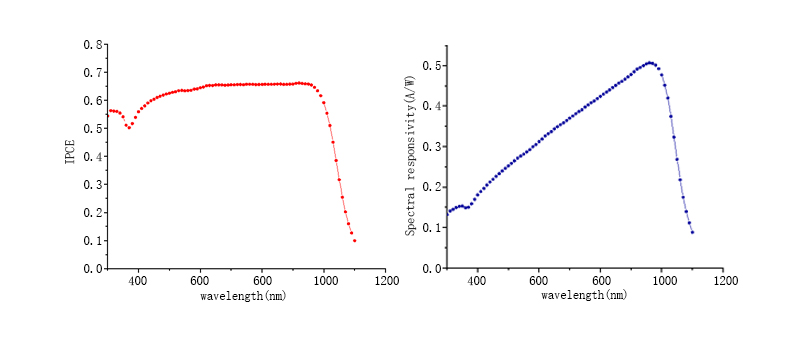As global warming continues to rise, the technology for producing green and clean energy from sunlight is constantly evolving. Photovoltaic (PV) electricity generation, as a means of utilizing the photovoltaic effect at semiconductor interfaces, can directly convert light energy into electrical energy and has begun to be widely adopted globally. The photovoltaic conversion efficiency is a key parameter for evaluating and constraining the application of PV technology.
Perfectlight Technology introduces the PL-IPCE solar cell testing system, which is a system designed to test the photovoltaic conversion efficiency of solar cells. It is equipped with a high-sensitivity, highly anti-interference lock-in amplifier system and a chopper system, enabling precise and stable measurement of light intensity and photocurrent.

● The chopper and ultraviolet detector, both crucial components, are equipped with state-of-the-art imported equipment in the field.
● The system employs fully automated software control, with functions including monochromator control, instrument readings, data comparison, and processing.
● Standard solar cells are provided by the metrology department and can be traced back to ISO 9000, ensuring accurate measurement data.
▲ Highly Suitable ● Moderately Suitable ○ Can Be Used
▲ Quantum efficiency (QE) measurement of solar cells
▲ IPCE (Incident Photon-to-Current Efficiency) measurement of solar cells

IPCE of the ultraviolet-enhanced silicon detector (left) and spectral response (right).
High Sensitivity, Strong Anti-Interference
The PL-IPCE solar cell testing system uses the American Standford SR830 lock-in amplifier to amplify weak currents, allowing measurement of photocurrent in the range of 1 pA to 1 μA.
The PL-IPCE solar cell testing system uses Standford SR540 chopper, which has a tunable frequency range of 4~3.7 kHz. Utilizing the time correlation between photocurrent and light signal and the filtering function of the lock-in amplifier, it can filter environmental light and current disturbances, further enhancing current detection sensitivity.
Triple Grating Design, Excellent Monochromatic Light Accuracy
The monochromator of the PL-IPCE solar cell testing system uses a triple grating structure. The adjustable entrance and exit slits range from 0.01 to 3 mm, ensuring monochromatic light accuracy of ±0.2 nm, with a half-width of 10 nm. The monochromaticity significantly surpasses the combination of a light source and filter set.
Continuously Adjustable Wavelength for Measuring Full Spectrum Photovoltaic Efficiency
The monochromator of the PL-IPCE solar cell testing system has a continuously adjustable wavelength range of 200~1000 nm (triple grating: 1200 L/mm, 1200 L/mm & 600 L/mm), with a minimum wavelength adjustment of 1 nm. Compared to the light source and filter set combination, it can measure photovoltaic conversion efficiency at any wavelength within the xenon lamp source's spectral range.
Standard Silicon Detector Certified by the National Metrology Department for Reliable Measurement Data
The PL-IPCE solar cell testing system uses the Japanese Hamamatsu S1337 standard ultraviolet-enhanced silicon detector. Its spectral response has been certified by the Chinese Institute of Metrology Science (with certification), within the range of 200~1100 nm and with a 5 nm wavelength interval, traceable to ISO 9000, ensuring reliable measurement data.
Light Source Parameters
● Total electrical power of the light source: 500 W;
● Wavelength range of the light source: 300~1100 nm;
Monochromator Parameters
● Focal length: 300 mm;
● Blaze wavelengths: 300 nm & 500 nm & 1000 nm;
● Triple grating: 1200 L/mm & 1200 L/mm & 600 L/mm;
● Wavelength range: 200~1100 nm;
● Resolution: 0.1 nm;
Chopper Parameters
● Chopping frequency: 4 Hz~3.7k Hz;
● Low phase jitter frequency and difference frequency reference signal output; single-beam and dual-beam modulation;
● Voltage-controlled input, four-digit frequency display, ten-stage frequency control, with two selectable operating modes for reference output;
Lock-In Amplifier Parameters
● Frequency range: 1 mHz-102k Hz
● Dynamic reserve: 100 dB;
● Phase resolution: 0.01°;
● Stability: 5 ppm/℃;
● Time Constant: 10 μs~10 ks;
● Photocurrent Range: 1 pA~1 mA; can synchronize with reference source signal
UV-Enhanced Silicon Detector Parameters
● Physical Parameters: 10×10 mm2;
● Operating Temperature Range: -20 ~ +60℃;
● Wavelength Usage Range: 190 ~ 1100 nm;
● Dark Current (25℃;-1V): 2×10-10A;
● Peak Wavelength: 960 nm;
● Peak Wavelength Responsivity: 0.5A/W;
Typical Customers
